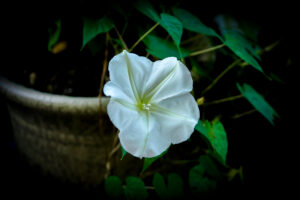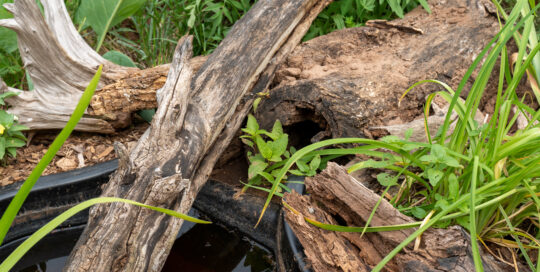Your garden in twilight and darkness
Views: 277

Most of us focus on our gardens during daylight hours. We may sit and enjoy a sunset on our patios or a beer around a fire pit. But once we head off to bed, the activity doesn’t stop. In fact, if the divots I wake up to every day are any indication, our landscapes are just as busy, if not busier, at night. Many animals are nocturnal, so they don’t get up and about until after the sun has set and the humans have disappeared inside. But plants are busy, too. Here are some of the things happening in our gardens during twilight and darkness.
Plants
Essentially, plants make food (glucose) during the day via photosynthesis and then use it at night. Plant respiration happens at night, combining the food they make during the day with oxygen to create energy. Plants then use this energy to heal and grow. Plants will also intake water at night, but typically less than during the day.
Nighttime pollination
Many flowers remain open for business (pollination) after dark, while others specialize in attracting nighttime pollinators. Research is beginning to show that nighttime pollinators are very important contributors to pollination in general… more so than expected.
Flowers pollinated at night often:
- Have white or dull colors to reflect moonlight
- Open late afternoon or night
- Have a strong fragrance
- Are ample nectar producers, with nectar deeply hidden
- Have flower clusters which provide landing platforms
Plants that rely on nighttime pollination
Some common garden plants rely primarily on twilight and nighttime pollination. These include:
- Morning glory
- Tobacco
- Evening primrose
- Yucca (many yucca species are entirely dependent upon the yucca moth for pollination)
- Four o’clocks
- Night-blooming jasmine
- Gardenia
The Night Shift
Many animals and insects help pollinate plants at night, including some surprises, such as mice. In some areas of the world, bats are important pollinators. If you have varieties of night-blooming cereus or Epiphyllum oxypetalum, their stunning white flowers and heavenly perfume are designed specifically to attract bats. But moths and beetles do most of the pollinating work after dark.
Moths probably do much more pollination than we’ve given them credit for, and research is starting to show this. There are more than 11,000 species in the USA.
Many beetles are active at night, as well. Beetles were around when flowering plants first appeared around 100 million years ago, and they were probably the first pollinators, so they have a special relationship with plants like magnolias, tulip trees (Liriodendron), paw-paw (Asimina), and sweetshrub (Calycanthus).
Helping the Night Shift
Moth and beetle populations are plummeting worldwide. The usual reasons (pesticides, habitat loss, and climate change) are to blame. But you can help them out by:
- Leaving areas of tall grass
- Reducing use of pesticides
- Leaving wet areas surrounded by vegetation
- Planting trees and leaving leaf litter
- Preventing composting worms from escaping
By helping out our native nighttime pollinators, you can ensure that we have fireflies, beautiful moths, and nighttime pollinators to help our morning glories and four o’clocks for years to come.
Meet Leslie Miller
Leslie Ann Miller shares 3.5 acres in rural Oklahoma with birds, butterflies and wide variety of animals. She is currently transforming her yard with plantings…
Leslie's Recent Posts

Creating microclimates and microhabitats to benefit wildlife






